| 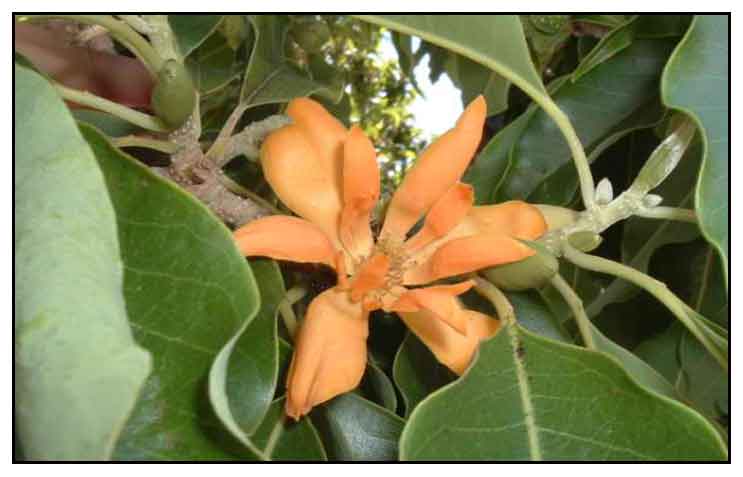
Gen info
- Michelia champaca belongs to the family Magnoliaceae, which consists of 12 genera and 220 species of evergreen trees and shrubs, native to tropical and subtropical South and Southeast Asia. (34)
- Magnolia champaca, known in English as champak, is a large evergreen tree in the family Magnoliaceae, native to the Indomalayan realm, consisting of South Asia, Southeast Asia-Indochina, and southern China. It was previously classified as Michelia champaca.
- Etymology: The genus name Michelia honors the Italian botanist Peter A. Michel (1679-1737). The species epithet champaca derives from the Sanskrit word campaka.
- Champak oil is considered the most expensive oil in the world, at about $2,200 per ounce
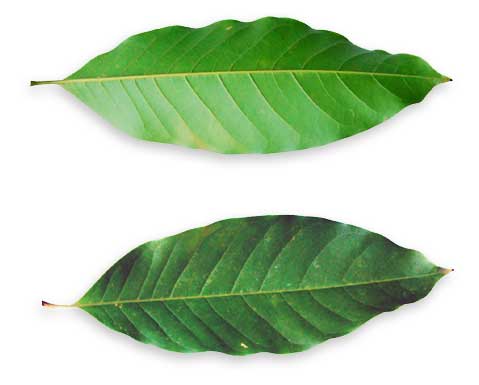 Botany Botany
• Tsampakang-pula is a small tree, growing
to a height of 6 meters or more. Bark is smooth and gray; the wood,
soft with a white sapwood and a light olive-brown heartwood. Young shoots
are silky; branchlets are appressed-pubescent. Leaves are ovate-lanceolate to oblong-lanceolate,
12 to 20 centimeters long, 2.5 to 6 centimeters wide, gradually narrowing upward to a long pointed
apex. Flowers are very fragrant, pale yellow or orange, 4 to 5 centimeters long. Perianth
segments are usually 15 to 20, deciduous, in whorls of 3, the outer
ones oblong, the inner ones linear. Fruiting spike is 8 to 15 centimeters long. Fruit is made up 3-20 brown follicles, dry at maturity and split open at one side; each follicle containing 2-6 seeds, brown when old, polished and variously angled.
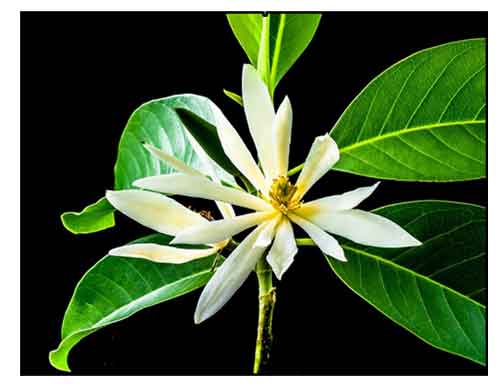 • Growth form: It can a free flowering tree, up to 30 – 50 m tall, and 183 – 190 cm diameter. Trunk is straight and columnar with smooth gray bark. Crown is cylindrical or conical. (Magnolia champaca var. champaca usually grow up to 2 – 5 (-30) m tall and 50 cm wide, while Magnolia champaca var. pubinervia usually grow up to 50 m tall and 180 cm wide.) Foliage: Leaf is elliptic or narrowly ovate (10 – 35 cm long by 4 – 11 cm wide), spirally arranged and slightly hairy on the underside. Leaf tip is short while leaf base is cuneate to rounded. There are 14 – 23 pairs of secondary veins which can be seen more visibly on the underside of the leaf. Petiole 1.5-3.5 (4) cm long. Stipules (up to 6.5 cm long) is hairy and attached to petiole for at least 0.7 – 3.9 cm long, leaving a ring-like stipular scar on the branches when it fallen. Flowers: Occurring singly on leaf axils or pseudo-axillary on brachyblasts, flower is fragrant, light yellow when young and becoming orange-yellow as it matures. Each flower is about 2 - 4.5 cm long, comprising of 5 tepals in several inconspicuous whorls where the outermost tepals are obovate and innermost tepals are narrower. Brachyblast is densely pubescent, with 2 (-3) nodes (0.5-) 1-1.8(-2.5) cm long. Stamen is 0.6 - 0.8 cm long, with connective appendages up to 0.1 cm long. Fruit: Fruit are borne on a spiral cluster (6 – 30 cm long) which hangs down. Each cluster consist of 6 – 40 individual fruit. Each fruit is 1.5 – 2 cm long, woody and pale brown with large cream colored lenticels. Ripe fruit splits open to reveal 2 – 6 seeds inside. Seed is covered with red or pink flesh and hang freely on a thin white thread.
(46) • Growth form: It can a free flowering tree, up to 30 – 50 m tall, and 183 – 190 cm diameter. Trunk is straight and columnar with smooth gray bark. Crown is cylindrical or conical. (Magnolia champaca var. champaca usually grow up to 2 – 5 (-30) m tall and 50 cm wide, while Magnolia champaca var. pubinervia usually grow up to 50 m tall and 180 cm wide.) Foliage: Leaf is elliptic or narrowly ovate (10 – 35 cm long by 4 – 11 cm wide), spirally arranged and slightly hairy on the underside. Leaf tip is short while leaf base is cuneate to rounded. There are 14 – 23 pairs of secondary veins which can be seen more visibly on the underside of the leaf. Petiole 1.5-3.5 (4) cm long. Stipules (up to 6.5 cm long) is hairy and attached to petiole for at least 0.7 – 3.9 cm long, leaving a ring-like stipular scar on the branches when it fallen. Flowers: Occurring singly on leaf axils or pseudo-axillary on brachyblasts, flower is fragrant, light yellow when young and becoming orange-yellow as it matures. Each flower is about 2 - 4.5 cm long, comprising of 5 tepals in several inconspicuous whorls where the outermost tepals are obovate and innermost tepals are narrower. Brachyblast is densely pubescent, with 2 (-3) nodes (0.5-) 1-1.8(-2.5) cm long. Stamen is 0.6 - 0.8 cm long, with connective appendages up to 0.1 cm long. Fruit: Fruit are borne on a spiral cluster (6 – 30 cm long) which hangs down. Each cluster consist of 6 – 40 individual fruit. Each fruit is 1.5 – 2 cm long, woody and pale brown with large cream colored lenticels. Ripe fruit splits open to reveal 2 – 6 seeds inside. Seed is covered with red or pink flesh and hang freely on a thin white thread.
(46)
Distribution
- Cultivated, not naturalized. (42)
- Cultivated for its flowers
and ornamental use.
- Widespread in the Indo-Malaysian tropical region.
Classified as Least Concern in the IUCN Red List of Threatened Species. (24)
- Native to Borneo, Cambodia, Jawa, Laos, Lesser Sunda Is., Malaya, Sumatera, Thailand, Vietnam.
(42)
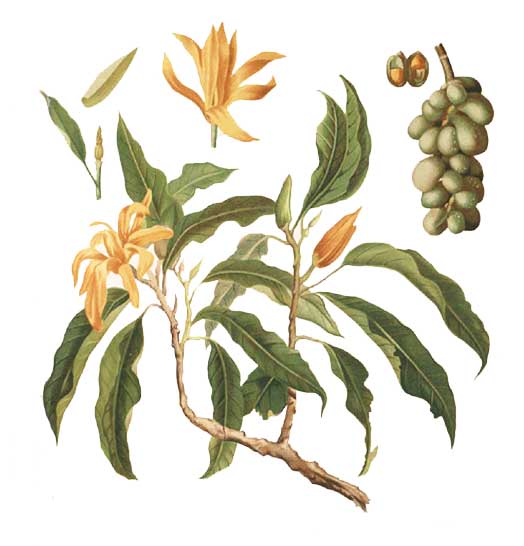 Constituents Constituents
- Volatile oil, 0.2% - cineol,
iso-eugenol, benzoic acid, benzyl alcohol, benzaldehyde, p-cresol methyl
ether; alkaloids.
- The bark contains a volatile oil, fixed oil, resin, tannin, mucilage,
starch and sugar.
- Studies have reported an alkaloid in M. parvifolia and M. champaca.
- Champacol, a camphor, has been obtained from champaca wood by distillation.
- Flower, seeds and bark contain a bitter and aromatic principle.
- A study reports a volatile oil from the leaves.
- Flower essential oil yields 62% linalool, beta-caryophyllene, beta-elemene, methyl eugenol.
- Constituent study of leaves and flowers yielded
alkaloids, saponins, tannins, glycosides, carbohydrates, amino acid, flavonoids, and sterols. (26)
- Stem bark
yielded triterpenoids, steroids, and fatty acids, with the absence of alkaloids, carbohydrates, flavanoids, glycosides, resins, saponins, and tannins. (29)
- Study of leaf essential oil isolated from 52 accessions of M. champaca by hydrodistillation varied in the range of 0.06% and 0.31% (v/w) on a fresh weight basis. GC-MS analysis identified a total of 65 phytoconstituents accounting for 90.23 to 98.90% of total oil. Major fraction consisted of sesquiterpene hydrocarbons (52.83 to 65.63%), followed by sesquiterpene alcohols (14.71 to 22.45%). The EOs were rich in ß-elemene (6.64 to 38-80%), γ-muurolene (4.63-22.50%), and ß-caryophyllene (1.10 to 20.74%). (44)
- Study of leaves isolated four new flavonol diglycosides, champaflavosides A-D (1-4), together with 23 known flavonoid glycosides. (see study below) (45)
Properties
- The bark is bitter, tonic,
astringent, antiperiodic and alterative.
- Root is purgative and the root-bark, emmenagogue, purgative and demulcent.
- The flowers are stimulant, tonic, carminative, demulcent and diuretic.
- Studies have suggested antitumor, anti-inflammatory, wound healing, antifungal, antihyperglycemic, diuretic, antimicrobial, anthelmintic, antioxidant, memory enhancing, hepatoprotective, cardioprotective properties.
Parts used
Leaves, root, root-bark, flowers, fruit and oil.
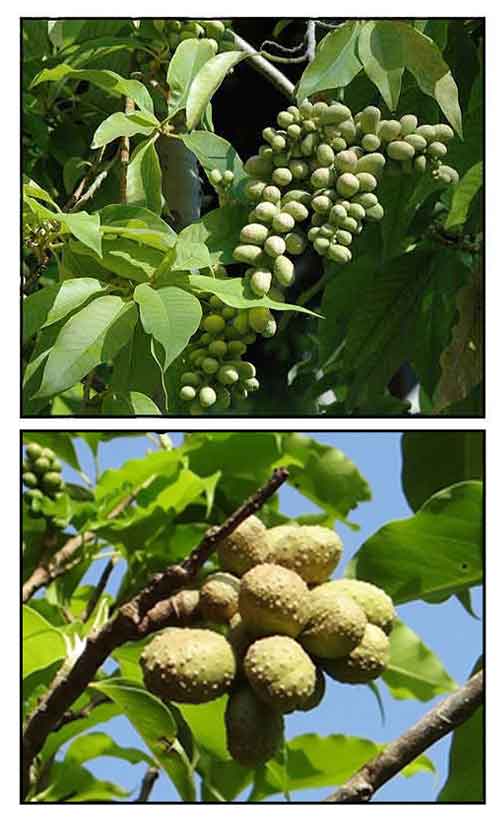 Uses Uses
Edibility
- Fruit reported to be edible.
Folkloric
- Whole plant traditionally used for the treatment of constipation, bronchitis, fever, abdominal colic, diabetes, amenorrhea, and rheumatism. Flowers used for fever, leprosy, colic, eye disorders, among others. (33)
- Flowers mixed with sesamum oil is externally applied in vertigo and for foetid discharges from the nostrils. Flowers and flower buds used for ulcers, wounds, and skin diseases. Dried root and bark used for abscesses and as purgative. (34)
-
Leaves applied to indolent swellings.
- Leaf juice used as vermifuge.
- Leaf juice with honey taken orally to relive colic.
- Decoction used in rheumatism, angina, and pharyngitis.
- Used for vertigo and dizziness.
-
Decoction
of bark used for fevers.
- Powdered bark also used for fevers.
- For rheumatism, crushed leaves are mixed with oil and applied on affected joints.
- Root bark used as demulcent, emmenagogue and purgative.
- An infusion or decoction of the flowers used for dyspepsia, nausea and
fevers.
- The flowers, macerated in sweet oil, used for cephalalgia and ophthalmia
and fetid nasal discharges; vertigo, rheumatism and gout.
- Seeds are used for rheumatism and for healing cracks in the soles of
the feet.
- In Mexico, flowers, seeds and bark used for renal affections and as abortifacient.
- In India, flower buds used for diabetes
and kidney diseases.
- Women of Chhattisgarh in India use the plant for fertility regulation.
- In Ayurveda, used for dyspepsia, nausea, vitiated conditions of pitta, vatta, hemoptysis, pruritus, skin diseases, cough, bronchitis, malarial fever, and general debility.
(23)
- Flower essential oil used for cephalalgia, ophthalmia, gout and rheumatism. Fruits and seeds used for healing cracks in feet. (31)
- Decoction of bark and leaves used as tonic after childbirth. Bark used as febrifuge. In Myanmar, flowers are used to treat leprosy; leaves used to treat colic. (37)
- Infusion of young leaves used as eye drops to cleanse the eyes and strengthen vision. Juice from crushed leaves and honey use to ease chest pains and expel parasites. Mixture of crushed flowers in cold water used as diuretic and as remedy for urinary tract and bladder problems. Decoction of flowers taken for gastric pain, gas disorders, kidney problems, and gonorrhea. Paste from fruits or seeds used as poultice to for cysts and boils. Mixture of crushed dried root or bark and yoghurt applied as poultice on sores. (47)
Others
•
Perfume: Flowers yield an essential oil used in perfume. Used for scenting rooms, perfumed floral necklaces, as floral
decorations strewn on bridal beds, and perfuming clothes in storage. Also used to scent hair oils.
• Timber: Heartwood is olive brown turning to dark brown with a greenish tinge upon exposure. Used for furniture, cabinetry, carvings, turnery, toy making, carving.
• Fuel: Tree used as firewood. Gross energy value of the heartwood is about 21,070 kJ/kg. (37)
• Fodder: Leaves are fed to silkworm. (37)
• Agroforestry: Used to reforest badly eroded areas in Java. Soil under tree cover reveals increased pH, soil organic carbon, and available phosphorus. (37)
• Antifungal: Leaf extracts reported to be toxic to rice fungus, Puricularia oryzae. (37)
Studies
• Cytotoxic
/ Antitumor: Study showed ethanol extract of bark of
Michelia champaca showed activity against human epidermoid carcinoma
of the nasopharynx test system. Active constituents isolated were sesquiterpene
lactones - parthenolide and costunolide. (1)
• Anti-Inflammatory :
Study of the methanolic extracts of flowers of M. champaca showed
anti-inflammatory activity presumed to be due to the presence of flavonoids
in the flowers. (2)
• Antidiabetic: Study of the ethanolic extract of M champaca exhibited significant dose-dependent antihyperglycemic activity but did not produce hypoglycemia in fasted normal rats. Results support the traditional use of the plant for various diabetic-associated complications. (3)
• Antifungal:
Study of crude extracts of M champaca yielded the maximum
number of growth inhibiting compounds against Cladosporium cucumerinum. (4)
• Leishmanicidal Activity
: One of the timber extracts that showed
potent leishmanicidal activity. (5)
• Wound Healing Activity in the Immunocompromised: Study showed the co-administration of dexamaethasone and M champaca significantly increased the breaking strength and increased hydroxyproline content. Results conclude M champaca is an effective agent for healing wounds in immunocompromised patients. (6)
• Anti-infective Activity : Study showed the dichlormethane extract of M champaca and A madagascariense showed the maximum number of growth inhibiting compounds against Cladosporium cucumerinum; the crude extracts showed activity against several phytophathogenic filamentous fungi. (7)
• Antihyperglycemic Activity / Flower Buds: Study evaluated various extracts of flower buds for antidiabetic activity. The ethanolic extract of M champaca exhibited significant dose-dependent antihyperglycemic activity but did not produce hypoglycemia in fasted normal rats. Results support the traditional use of the plant for various diabetic-associated complications. (10)
• Flower Phytochemicals : Study of flowers of M champaca yielded flavonoid quercetin and an unidentified flavonoid glycoside together with 3-sitosterol, unsaturated aliphatic ketones and hydrocarbons. (8)
• Antioxidant / Antimicrobial / Flower: Study showed M. champaca flower extract possesses strong antioxidant and antimicrobial activities. (11)
• Wound Healing / Flower: Ethanolic extract of flowers was evaluated for burn wound healing activity in rats. Oral and topical administration showed significant improvement in rate of wound contraction, with reduction in period of epithelialisation. Dexamethasone-suppressed epithelialisation was significantly reversed by topical and oral treatment. (12)
• Antimicrobial and Anticancer Constituents: Study was carried out to characterized the antimicrobial, antioxidant, and anticancer activities of M. champaca seed and flower extracts. Findings indicate that the medicinal values of champaca seed and flower extracts in terms of antimicrobial and anticancer properties are promising. (13)
• Diuretic / Leaves and Stem Bark: Aqueous extracts of stem bark exhibited better diuretic potential in comparison to leaves extract, with the higher dose evoking pronounced diuresis even greater than standard furosemide (Lasix) in terms of Na+ and K+ concentration, and approximating furosemide in terms of urine volume. (14)
• Anti-Ulcerogenic / Flowers and Leaves: Alcoholic and aqueous extracts of leaves and flowers were evaluated for anti-ulcerogenic property. against NSAID-aspirin induced ulcer. Results showed significant reduction of gastric juice, total acidity, ulcer index, and elevation of gastric pH. Flower aqueous extract showed maximum efficacy followed by leaf alcoholic, flower alcoholic, and leaf aqueous extracts. (15)
• Antibacterial / Radical Scavenging Activity: Ethyl acetate and hexane extracts showed strong antioxidant activity in the S|DPPH radical scavenging assay. The ethyl acetate extract was more effective against all bacterial strains tested.
(16)
• ß-Sitosterol / Leaves and Stem Bark: ß-sitosterol is an important plant sterol reported to possess chemopreventive and adaptogenic properties. Study showed the leaves to be the richest source of ß-sitosterol in Michelia champaca. (17)
• Antifertility: Study evaluated the anti-fertility activity of a hydroalcoholic leaf extract in female rats. Results showed significant antifertility effect which may be due to inhibition of implantation and estrogenic effect due to some phytoconstituents. (18)
• Anti-Inflammatory / Leaves: Study evaluated various extracts on carrageenan-induced inflammation rat model. Results showed highly significant maximum inhibition concluding anti-inflammatory activity in pro-inflammatory conditions. (19)
• Anthelmintic: Study evaluated the anthelmintic activity of methanolic and aqueous extracts of leaves against test worms Pheretima posthuma. Both extracts exhibited greater P (paralysis time) and D (death time) than the standard. (20)
• Cardioprotective / Flowers: Study evaluated the cardioprotective potential of methanolic extract of M. champaca flowers on isoproterenol-induced myocardial ischemia in male albino wistar rats. Pretreatment with various doses showed dose-dependent cardioprotective benefits with restoration of biochemical parameters and histopathological confirmation of biochemical findings. (21)
• Anti-Inflammatory / Flowers: Study evaluated the anti-inflammatory property of a flower extract of M. champaca by membrane stabilization method by prevention of hypotonicity induced human RBC membrane lysis. M. champaca showed significant stabilizing activity of 57.4% at 300 µg/ml. Membrane stabilization was concentration dependent. (25)
• Antioxidant / Flowers: Study evaluated the antioxidant activity of methanolic extract of M. champaca flowers using in-vitro assay models. The extract showed effective free radical scavenging at 300 µg concentration. Ethanolic extract showed IC50 values of 260 µg in total antioxidant activity, 150 µg in NO radical assay, 240 µg in reducing power assay, and 280 µg in H2O2 assay. (27)
• Wound Healing in Diabetic Rats / Flowers: Study evaluated the wound healing property of ethanolic extract of flowers in streptozotocin-induced diabetic rats. Results showed significant increases in breaking strength, rate of wound contraction, and hydroxyproline content and reduced period of epitheliazation in groups IV and V. (28)
• Antihyperlipidemic: Study evaluated M. champaca extract for hypolipidemic activity on triton WR 1339 induced models of hyperlipidemia in rats. A methanolic extract showed significant reduction in TC, triglycerides, LDL, VLDL, MDA and GSH with increase in HDL, similar to standard drug atorvastatin. (30)
• Antimicrobial / Flower Essential Oil: Study evaluated essential oil of M. champaca flowers obtained by n-hexane extraction for antimicrobial activity. A slight inhibition was found against Staphylococcus aureus. (31)
• Ameliorative Effects in GI, Respiratory and Cardiovascular Disorders: Study evaluated the mechanisms of ameliorative effect on GI, respiratory and cardiovascualr disorders. Antispasmodic potential of aqueous-ethanolic extract was studied on rabbit aorta, trachea, and jejunum in vitro, M. champaca showed spasmolytic, airway relaxant, and vasodilator actions mediated perhaps by blocking of Ca2+ channels, hence validating its use in diarrhea, asthma and hypertension. (32)
• Anticancer / Flower: Study evaluated the anticancer activity through MTT assay. against human breast adenocarcinoma cells (MCF-7 cell lines). At maximum concentration, the IC50 was 1.86 ± 0.21 µg/ml. (33)
• Anti-Ulcerogenic / Flower and Leaves: Study evaluated the anti-ulcerogenic property of alcoholic and aqueous extracts of leaves and flowers. Anti-ulcer assays were performed using NSAID-aspirin induced ulcer. Results showed significant reduction of gastric juice, total acidity, ulcer index, and elevation in gastric pH. Results were comparable to cimetidine. (35)
• Antimicrobial / Leaf and Stem: Study evaluated leaf and stem extracts for invitro antimicrobial efficacy. Phytpchemical analysis of various solvent and water extracts yielded tannins, glycosides, steroids, flavonoids, anthraquinones, coumarins and lactones, phlobatanins, and reducing sugars. Invitro antimicrobial activity was tested against nine bacteria and two fungi. Hexane and chloroform extracts showed more potency and inhibitory activities against a majority of the isolates, with highest inhibitory activity observed against S. aureus with ZOI diameter of 31 mm. (36)
• Magnoflorine for Skin Diseases: Staphylococcus aureus is one of the main causative pathogens in skin diseases. Study sought to identify the phytochemical in M. champaca that can cure skin disease associated with S. aureus can e. Molecular docking study identified Magnoflorine, which can effectively deactivate thymidilate synthase thereby interrupting the life cycle of the organism. (38)
• Procognitive Effects for Skin Diseases / Nootropic: Study evaluated the nootropic potential (memory enhancing effects) of hexane extract of leaves of M. champaca using rectangular maze and Y-maze (behavioral models). Results showed higher doses of extract exhibited more promising nootropic potential. The hexane extract afforded mild memory enhancing effects, the higher dose evoking pronounced alteration of behavior and better learning assessments. (39)
• Restoration of Memory and Acetylcholinesterase Activity: Study evaluated
the effect of M. champaca in chronic noise-stress induced memory impairment in male Wistar albino rats. Results showed M. champaca attenuates memory deficits induced by chronic stress in albino rats and may have potential therapeutic use for stress related cognitive dysfunctions. The reduction in levels of serum corticosterone and inhibition of cholinesterase enzyme may contribute significantly to the positive effect of M. champaca. (40)
• Anticancer / Ehrlich Ascites Carcinoma / Antioxidant / Stem-Bark: Study evaluated the antiproliferative effect of M. champaca stem-bark extract against Ehrlich ascites carcinoma (EAC) cells in vivo. The bark extract showed strong antioxidant activities (p<0.001) strongly correlated with phenolics and flavonoid contents. The extract decreased tumor cell proliferation, tumor weight, and increased the span of tumor bearing mice. The extract also altered hematological parameters towards normal in tumor bearing mice. There was upregulation of p53, Bax and downregulation of Bcl-2. Results suggest the bark extract could induce apoptosis of EAC cells. (41)
• Hepatoprotective / Carbon Tetrachloride Toxicity / Flowers: Study evaluated the
hepatoprotective activity of flower extract of M. champaca against CCl4-induced liver injury in rats. Treatment significantly reversed the elevated liver enzyme markers and renal markers. Results showed promising hepatoprotective effect. (42)
• Antioxidant Flavonoid Glycosides / Leaves: Study of leaves isolated four new flavonol diglycosides, champaflavosides A-D (1-4), together with 23 known flavonoid glycosides. All compounds were evaluated for antioxidant activity by invitro assays. Compounds 3-12 and 20 showed more potent DPPH radical scavenging activity than L-ascorbic acid (L-AA). Compounds 2-23, 25, and 27 exhibited ABTS radical cation scavenging activity
superior to L-AA. Compounds 2-13, 17, and 19 showed higher FRAP antioxidant powers than L-AA. Eighteen compounds demonstrated cellular reactive oxygen species (ROS) scavenging activity, with compounds 4, 8, 9, and 27 showing greater potency than curcumin. Results revealed the renewable leaves as a rich source of flavonoids and antioxidants. (45)
Availability
- Cultivated
- Wild-crafted.
- Infusions, extracts, teas, perfume oils, essential oils in the cybermarket. |


![]()

